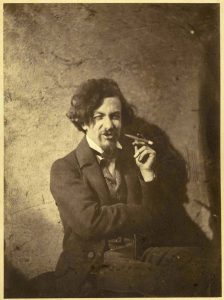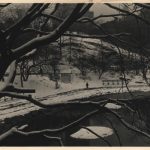Month: November 2012
Le Gray is well known for his technical innovations and distinctive photographs as well as for his teaching of other notable photographers. His architectural, landscape and portrait photographs were influential and he was an important contributor to the development of the wax paper negative. In the 1850s the photographer started using collodion-on-glass negatives in preference to paper negatives in order to achieve increased sharpness of the image
and faster exposure times.
His students included Charles Nègre, Henri Le Secq, Nadar, Olympe Aguado, and Maxime Du Camp. In 1851, he became one of the first five photographers hired for the Missions Héliographiques to document French monuments and buildings. Despite his success, he became bankrupt in 1860. He left his life in France for travels in Italy, before settling in Egypt where he continued to take photographs.
Selected exhibitions:
2003
“Sea and Sky: Photographs by Gustave Le Gray 1856-1857”, Victoria and Albert Museum, London, UK
2002
“Gustave Le Gray, Photographer”, Getty Center, Los Angeles, USA
1999
“Museum as Muse: Artists Reflect”, Museum of Modern Art, New York, USA
1998
“Beyond the Edges: An Insider’s Look at Early Photographs”, The Metropolitan Museum of Art, New York, USA
1987
“The Photography of Gustave Le Gray”, Art Institute of Chicago, Chicago, USA

January 11, 2013 — February 16, 2013
“Night and day, he prowled the streets and tall buildings of Manhattan…”
Wanda Rickerby
Daniel Blau is delighted to present an exhibition of vintage prints by renowned American photographer Arthur B. Rickerby (1921 – 1972). Best known for his depictions of New York life and organised sport, Rickerby also covered World War II events in the Pacific under Edward Steichen.
A native New Yorker, he photographed the city all his life – as a United Press employee, a freelancer, and later as one of the prestigious LIFE magazine staff photographers. The variety of subjects he covered is remarkable, from street scenes to union strikes, to President Kennedy and happenings abroad.
This is the first time that these rare vintage prints will be shown in a solo exhibition in Europe, representing the discovery of a historically important photographer who bore witness to many of the great events of the Twentieth Century.
Arthur Burroughs Rickerby was born in New York City in 1921. He began his photographic career while a student at Duke University (Durham, North Carolina), where he documented the campus sports to sell his images to local newspapers. Acme Newspictures (now UPI) noticed him and offered him a job in New York after his graduation. As this coincided with the Second World War, however, he was sent to the Pacific to cover the events under Edward Steichen.
Upon the end of the war, he returned to his job as a photojournalist in New York, recording every aspect of the city and always testing new photographic equipment, such as 35 mm film. He was nominated for a Pulitzer prize for his leadership in the world of news photography. He left United Press to become a freelancer, and as he became better known, was hired by the prestigious LIFE Magazine, with which he shot exclusive stories about president Kennedy. He continued photographing a wide variety of subjects throughout his life.
A retrospective of Rickerby’s work, entitled “The Photography of Arthur B. Rickerby, The UPI and LIFE years, 1941-1971”, toured the USA in the 1990s.






 +49 89 29 73 42
+49 89 29 73 42